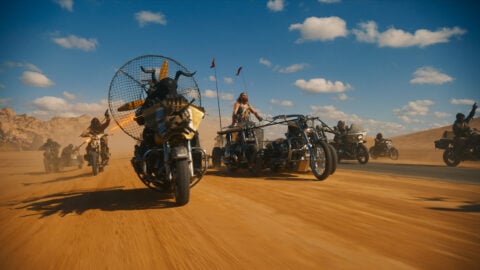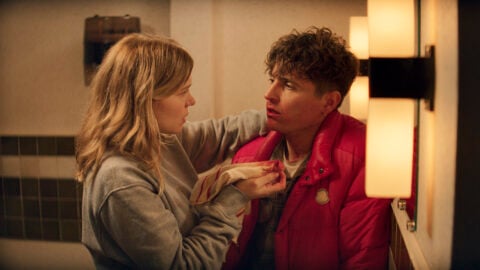Making Sense of Life: Open City Documentary Festival 2024
This article appeared in the May 3, 2024 edition of The Film Comment Letter, our free weekly newsletter featuring original film criticism and writing. Sign up for the Letter here.
 The Soldier’s Lagoon (Pablo Álvarez-Mesa, 2024)
The Soldier’s Lagoon (Pablo Álvarez-Mesa, 2024)
Since taking over as director of the Open City Documentary Festival in 2021, María Palacios Cruz has ushered in a series of structural innovations to London’s key nonfiction showcase that, on the evidence of this year’s edition, feel exemplary. Competition strands have been done away with and the restrictive need for premieres jettisoned, while the festival’s move from the fall to the spring also places it in a less frenzied section of the calendar and should bring a deserved increase in attention. The 2024 program felt diverse, precisely calibrated, and appealingly egalitarian in its approach. Short and feature-length works culled from the current festival circuit were flanked by intriguing thematic programs on the figure of the grandmother in cinema and capturing Chinese folk memory on film. Retrospectives dedicated to the work of American avant-garde filmmaker Amy Halpern and Afro-Cuban documentarian Nicolás Guillén Landrián rubbed shoulders with contemporary focuses on Jessica Sarah Rinland and Simon Liu. The latter two were given the opportunity to curate programs of their own influences in turn, producing a fascinating overview of the history of Hong Kong dissident cinema and a tribute to Argentine experimental veteran Narcisa Hirsch.
All manageably scaled, these various program components were simply placed alongside each other without hierarchy or selective emphasis, fostering a vision of cinema that sees no difference between past and present, and pays the same heed to different geographies, modes, traditions, durations, political positions, and production contexts. Open City also showed admirable invention and lightness of touch in terms of referencing the painful events still unfolding in the world outside the festival bubble. The five playlists curated by Palestinian Sound Archive founder Mo’min Swaitat that were played in the auditoria before each screening ensured that Palestinian voices were literally heard across the entire festival, while an emotional event entitled “Stolen Films Imaginary,” conceived by filmmaker Saeed Taji Farouky, focused on the films stolen from the Palestinian Cinema Institute’s archive by Israeli forces during the 1982 siege of Beirut, “reconstructing” them on a blank screen based on written records and testimonies from the time. Description and recollection are no replacement for the actual films, but they can at least keep their memory alive.
The lack of suitable screening prints for key works of Palestinian cinema was also highlighted by Of the People, for the People: Militant Palestinian Cinema (1968-1982), a shorts program curated by Farouky. Of the five films in this roundup, only Jocelyne Saab’s Palestinian Women (1973), made for French television but never aired, and the formally radical They Do Not Exist (1974), directed by Godard collaborator Mustafa Abu Ali, were screened close to their original state thanks to recent restorations. Watching this program move between grainy, deteriorated images of Gaza under siege, the misery of bombed refugee camps, and repeated articulations of the seeming impossibility of peace was a sobering reminder of just how little has changed in five decades.
Among the new films, Pablo Álvarez-Mesa’s The Soldier’s Lagoon, which arrived at Open City fresh from Cinéma du réel, crafts a portrait of a contested territory spanning centuries. Simón Bolívar’s pro-independence army crossed the sodden, fog-wreathed Páramo de Pisba region of the Colombian Andes in 1819 to catch the Spanish troops off guard, with the inhospitable terrain costing many soldiers their lives: their watery mass grave gives the film its name. But this campaign is only one layer of this landscape’s history. As is detailed in voiceover, it has been home to the Indigenous Muisca people for centuries, who managed to carve out relative autonomy from the Spanish Crown, a position which was later compromised by Bolívar’s military operation. The region’s perpetual fog has provided the perfect cover for more recent paramilitary operations, while its vast fields of water-trapping frailejón plants and the unique local fauna have also drawn waves of researchers over the last 50 years. Capturing the verdant hues and all-pervading humidity of the páramo on glistening 16mm celluloid and making ravishing use of superimposition, The Soldier’s Lagoon carves an intuitively winding and mesmerizing path across this still-charged space, particularly in its final dive into the depths of the lagoon, which briefly makes the body of water and the cinema space become one.
Attuned to the feminist, historical, cinematographic, but also workaday insights that can be gleaned from the lives of grandmothers, the “Grandma’s Grammar” program curated by film scholar Elena Gorfinkel was structured around an idea at once off-kilter and brimming with potential. What other presence contains the knowledge accrued across a whole life and can offer wisdom without being drawn into the complicated entanglements of the mother-child bond? (There’s a reason why no one ever talks of “grandmommy issues.”) In Jean-Pierre Bekolo’s Grandma’s Grammar (1996), included in this section, Senegalese filmmaking legend Djibril Diop Mambéty talks of how his grandmother always urged him to go further and constantly re-interrogate his approach to storytelling. Gunvor Nelson’s Red Shift (1984) weaves a free-floating and deeply sensual gossamer of impressions around three generations of women: the filmmaker, her young daughter Oona, and Oona’s grandmother (Nelson’s own mother).
But among many redoubtable women, one stood out: Someya Katsu, the octogenarian protagonist of Katsuhiko Fukuda’s A Grasscutter’s Tale (1985), a major discovery in a festival full of them. Fukuda was a member of Ogawa Productions, a Japanese documentary collective that captured rural life and political resistance with organicism and quiet grace, and he brings a similar patience, intensity, and deceptive simplicity to his portrait of the still-working farmer and grandmother. The film is split into 19 chapters, each of which is marked with a handwritten title card and employs more or less the same format. Someya speaks to Fukuda at length about some aspect of her life, usually in voiceover, and her account is accompanied by 8mm images of her working in the fields, in a factory, or at home: repetitive movement, wrinkled hands, energy undimmed.
Each chapter zeroes in on a different aspect of Someya’s existence (work, class, marriage, motherhood, family), and is a miniature autobiographical testimony all of its own, thanks to Fukuda’s astute decision to ignore chronology and embrace a degree of redundancy. As all these distinct threads are progressively woven together, a wonderfully compassionate portrait of a life of endless hardship—dead children, marital discord, repeated professional setbacks—comes into ever sharper view. That the overriding impression is ultimately one of joy feels like a miraculous illustration of where the wisdom of the grandmother can ultimately lead: all the decades spent trying to make sense of life were not in vain.
James Lattimer is a festival programmer, film curator, and critic based between Berlin and Athens.







